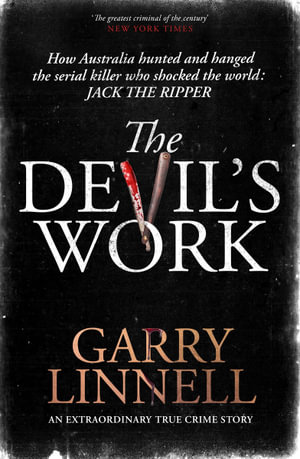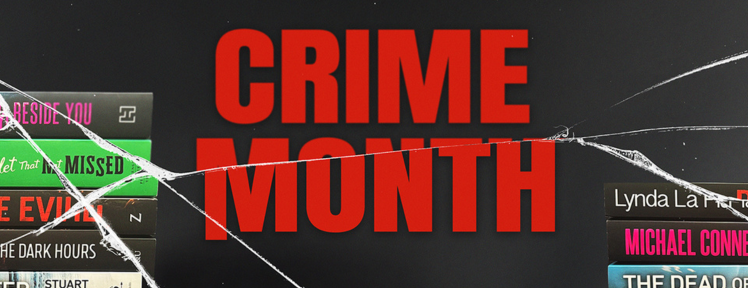Garry Linnell is one of Australia’s most experienced journalists. Born and raised in Geelong, he has won several awards for his writing, including a Walkley for best feature writing. He has been editor-in-chief of The Bulletin, editor of The Daily Telegraph, director of news and current affairs for the Nine Network and editorial director of Fairfax. He spent four years as co-host of the Breakfast Show on 2UE and is also the author of five books, the latest of which is called The Devil’s Work.
Today, Garry Linnell is on the blog to answer a few of our questions about his new book. Read on …

Garry Linnell (Photo by Fairfax).
Please tell us about your book, The Devil’s Work.
GL: It’s a very gothic story about a suspect in the Jack the Ripper killings named Frederick Deeming. He was a serial murderer, bigamist and swindler who embarked on a decades-long crime spree around the world in the late 19th century. He cut the throats of two of his wives and all four of his children. He was finally arrested by Australian police and executed in Melbourne. The New York Times dubbed him the ‘Criminal of the Century’.
How did you first come across the story of Frederick Deeming and what made you realise that you wanted to write a book about it?
GL: I stumbled across it after researching the early years of Alfred Deakin, our second Prime Minister, for a separate project. Deakin was a barrister in desperate need of work when he took on the job of defending Deeming during his murder trial in Melbourne in 1892. Deeming claimed he was haunted by his dead mother whose ghost urged him to kill. Deakin had been a committed spiritualist as a young man who believed he could speak to the dead. It turned out both men had something in common …
Deeming’s crimes were quite sensational and horrific, spanning three continents. Why do you think he was able to evade justice for so long?
GL: Policing as we know it was still in its infancy at the time. The science of fingerprinting did not become widely used until the early 20th century and it was very easy to change your identity and move around the globe by ship. Few countries required passports or other identification and border controls were often very lax.
The 19th century was a very unusual time in history, in terms of the role played by science and religion in public life. Can you briefly tell us about the impact of these things on the Deeming case?
GL: It was an era when science and religion really began to collide and I was staggered at the influence of spiritualism, particularly among the middle and upper classes. Apart from Deakin’s involvement, Deeming’s solicitor, Marshall Lyle, was also a believer in an afterlife where the spirits of the dead could communicate with the living. Another main character in the book is Sidney Dickinson, an American journalist who spent several years in Australia and covered Deeming’s case for The New York Times. Dickinson was living in a house in Melbourne he believed was haunted. His wife was also a palm reader who had been a prominent medium back home in Boston, hosting seances where tables and chairs were seen levitating. How can you not love a story that blends crime, horror and mysticism?
Can you tell us a little bit about your approach to research when it comes to writing history?
GL: Read. Read again. And then read some more. Documents. Diaries. Court reports. Journals … not to mention thousands of archived newspaper pages from the UK, Australia, New Zealand and the US. While I’m looking for facts, I’m also searching for clues and hints about the personality of various characters. Unless you can bring those characters to life, you’re left with a story that might be filled with details but lacks the human element necessary for a great story.
‘It’s all about the people. When I come across interesting characters – and the 18th and 19th centuries were brimming with the mad, the bad and the delightfully eccentric – I become almost obsessed with their beliefs, their personality traits and even what they ate and drank.’
What is the most surprising thing you learnt while researching and writing this book?
GL: As someone who used high school history classes as a chance for a nap, where do I start? I don’t think I’d appreciated or fully understood how Australia was shaped and forged by immigrants in the 19th century. Almost every character involved in this book had either sailed to this country in search of a better life, or were sons and daughters of parents who had. They undertook hazardous sea journeys to come to a place they knew little about. They clung to hope. No wonder so many of them believed in an afterlife!
What do you love about writing history?
GL: It’s all about the people. When I come across interesting characters – and the 18th and 19th centuries were brimming with the mad, the bad and the delightfully eccentric – I become almost obsessed with their beliefs, their personality traits and even what they ate and drank. I try to reconstruct them for 21st century readers so they can recognise, understand and, in some cases, empathise with them.
What is the last book you read and loved?
GL: I’ve just finished Hemingway’s Boat by Paul Hendrickson. What an amazing tale. He tells the story of Ernest Hemingway’s remarkable life and work using the great writer’s boat Pilar as the chief character. Beautifully written and incredible moving. When I read a book like that I always experience a twinge of jealousy and think ’I wish I had’ve written that…’
What do you hope readers will discover in The Devil’s Work?
GL: Hopefully they’re not easily spooked. They’re going to enter a gothic world inhabited by ghosts, demons and worn-out detectives hunting down a crazed serial killer whose dead mother keeps waking him up every night urging him to kill. And it’s all true!
And finally, what’s up next for you?
GL: I’ve just started research for another non-fiction book that I’m very excited about and I also have a novel I’m hoping to complete in the next 12 months. And if I get the time I would really like to conquer the science of making great sourdough bread …
Thanks Garry!
—The Devil’s Work by Garry Linnell (Penguin Books Australia) is out now.

The Devil's Work
He was a murderer, swindler, bigamist and suspect in the Jack the Ripper killings. Frederick Deeming was also the most hated man in the world.
Claiming to be haunted by the ghost of his dead mother, Deeming had spent years roaming the planet under various aliases, preying on the innocent, the gullible and the desperate. But the discovery by Australian police in 1892 of the body of one of his wives in a shallow concrete grave triggered one of the greatest manhunts in history and exposed a further series of grisly murders – those of his first wife and four children - that stunned the Victorian era...







 What do we know about the Boy Swallows Universe Netflix show?
What do we know about the Boy Swallows Universe Netflix show?  Booktopia’s top thrilling fiction picks for Crime Month
Booktopia’s top thrilling fiction picks for Crime Month  Booktopia’s Top First Nations Book Recommendations for 2023
Booktopia’s Top First Nations Book Recommendations for 2023
Comments
No comments